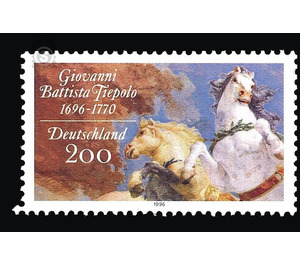300th birthday of Giovanni Battista Tiepolo - Germany / Federal Republic of Germany 1996 - 200 Pfennig
Theme: Art & Culture
| Country | Germany / Federal Republic of Germany |
| Issue Date | 1996 |
| Face Value | 200.00 |
| Color | brown |
| Perforation | K 13:12 1/2 |
| Printing Type | Multicolor offset printing |
| Stamp Type | Postage stamp |
| Item Type | Stamp |
| Chronological Issue Number | 1720 |
| Chronological Chapter | GER-BRD |
| SID | 110316 |
| In 35 Wishlists | |
Giovanni Battista Tiepolo, born on March 5, 1696 in Venice, died on March 27, 1770 in Madrid, is considered the most important painter of Italian late Baroque. His work includes frescoes, panel paintings, drawings and etchings. However, the most important field of work for the artist was always the fresco painting. There are usually monumental decoration systems for walls and ceilings in churches, city palaces or villas. In doing so, the artist developed from the traditions of Venetian silk painting to a painter of light and luminous, often transparent colors. A new style, which of course was favored by the possibilities of the fresco technique. This is also the case in Tiepolo's main work, the design of the prince-bishop residence built by Balthasar Neumann in Würzburg (1750-1753). The staircase was one of the largest ceiling paintings in Europe. (The depiction of the Apollo and the four continents enthroned on the Olympus includes an apotheosis of the patron Carl Philipp von Greiffenclau.) Previously, the artist had already painted the Kaisersaal with allegorical-historical frescoes from the early history of the Würzburg diocese. The stamp shows a detail of the ceiling fresco in the Emperor's Hall: Two of the powerful steeds of the Apollonian Sun Carriage, on which the God of Light feeds Beatrix of Burgundy to the genius of the Holy Roman Empire of the German Nation. (Text: Peter Daners M.A., Bonn)


